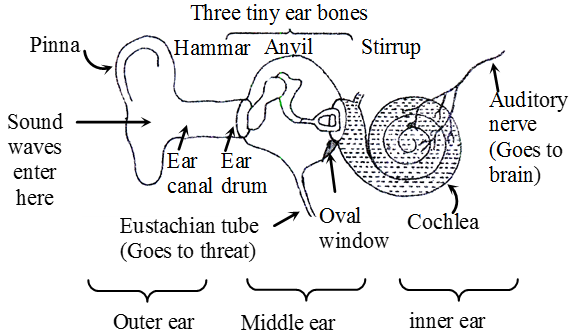Human Ear Structure And Function
We have just learnt how sound vibrations from a source propagate through the air and reach our ears. Let us now discuss how our ears actually ‘hear’ these sound vibrations. The ear can be broadly classified into three parts: the outer ear, the middle ear, and the inner ear.
(a) Structure of Human Ear
The ear consists of three compartments, outer ear, middle ear and inner ear.
- The part of ear which we see outside the head is called outer ear. The part of the outer ear that is visible to us is called pinna. The pinna collects sound waves and directs them to the ear tube. At the end of the ear tube is the ear drum (also called tympanum). The ear drum vibrates when sound waves strike it and transmits the sound to the middle ear.The outer ears consists of broad part called pinna and about 2 to 3 centimeters long passage called ear canal. At the end of ear canal there is a thin, elastic and circular membrane called ear-drum. The ear-drum is also called tympanum. The outer ear contains air.
- The middle ear is a cavity with three important ear bones. These three bones are placed in such a way that they move when the ear drum vibrates and, therefore, transmit the vibration to the inner ear. The middle ear contains three small and delicate bones called hammer, anvil and stirrup. These ear bones are linked to one another. One end of the bone called hammer is touching the ear-drum and its other end is connected to the second bone called anvil. The other end of anvil is connected to the third bone called stirrup and the free end of stirrup is held against the membrane over the oval window of inner ear. The middle ear also contains air.
- The inner ear is connected to the middle ear through a small opening. The inner ear is filled with a fluid. When this fluid vibrates, it excites tiny hair in the inner ear. These hair transform the vibrations into electrical impulses, which are then transferred to the brain via the auditory nerve. This is how we ‘hear’ a sound. The lower part of middle ear has narrow tube called ‘eustachian tube’ going to the throat. Eustachian tube connects the middle ear to throats and ensures that the air pressure inside the middle ear is the same as that on the outside.

- The inner ear has a coiled tube called cochlea. One side of cochlea is connected to the middle ear through the elastic membrane over the oval window. The cochlea is filled with a liquid. The liquid present in cochlea contains nerve cells which are sensitive to sound. The other side of cochlea is connected to auditory nerve which goes into the brain.
(b) Working of Human Ear
- Sound waves from outside are collected by the outer ear (called pinna) and reach the eardrum through the auditory canal. When the sound waves strike the eardrum, (tympanic membrane) it starts vibrating. These vibrations are passed on to the oval window by three bones (called the hammer, anvil and stirrup) which act as a lever with the pivot at point P. They magnify the force of the vibrations.
- The oval window has a smaller area than the eardrum. So, this increase pressure on the oval window and on the liquid in the cochlea.
- The vibrations of the liquid in the cochlea affect thousands of auditory nerves which send message to the brain. Our ears are very delicate and fragile organs. Proper care must be taken to keep them in healthy state.
Some suggestions to keep the ears healthy are given below
- Never insert any pointed object into the ear. It can damage the eardrum and make a person deaf.
- Never shout loudly into someone’s ear.
- Never hit anyone hard on his / her ear.
